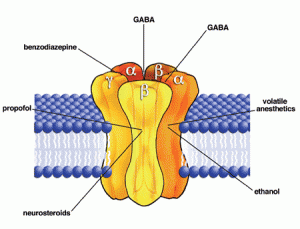I’m currently studying the sedative-hypnotic group of drugs. There is a great deal of chemical variation within the group, so a drug is classified as a sedative-hypnotic based upon it’s clinical effects, and not on it’s chemical makup.
One class of drugs within the sedative-hypnotic group is the benzodiazepines. The benzos work by binding to a receptor site between an alpha subunit and a gamma subunit on a GABAA receptor chloride channel, where they potentiate the action of GABA by increasing the frequency of opening of the GABAA chloride channel. The GABAA channel is constitutively active, which means that it opens and closes on its own at a regular rate. When different chemicals bind to receptor sites on the GABAA channel, they can change the way the channel opens or closes.
The benzodiazepines are agonists, that is, they help open the GABAA chloride channel. As mentioned above, they increase the frequency at which the GABAA chloride channel opens. A few common benzodiazepines are diazepam, clonazepam, and lorazepam.
The barbiturates are also agonists. Unlike the benzodiazepines, they don’t change the frequency of at which the GABAA channel opens. Instead, they increase the amount of time that the channel stays open once it is activated. Common barbiturates are phenobarbital, pentobarbital, and thiopental.
GABA agonists all have similar actions: sedation, anticonvulsant effects, muscle relaxation, and anesthesia.
Another drug, flumazenil, is an competitive antagonist of the GABAA receptor at the benzodiazepine binding site and is used as an antidote to benzodiazepines and the non-benzodiazepine benzodiazepine-receptor agonists (NBBRAs).
Now we come to the drugs which are the actual focus of this post, the beta-carbolines. The beta-carbolines are inverse agonists of the GABAA receptor function. They block the normal, constitutive, action of the GABA chloride channel. So they decrease the amount of chloride that enters the cell, reducing the polarization of the neuron, and increasing the chance that the neuron will fire. As we would expect from a chemical that has the opposite effect of an agonist, beta-carbolines can cause anxiety and seizures.
But the beta-carbolines also seem to have another effect: increasing learning performance and memory. According to this article from 1986, Benzodiazepine impairs and beta-carboline enhances performance in learning and memory tasks, beta-carbolines help us learn and remember.
While we may not have access to the USP version of the chemical used in the article above, there is another readily available source of beta-carbolines: coffee.





